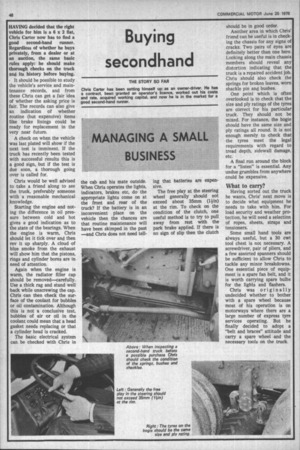Buying secondhand
Page 50

If you've noticed an error in this article please click here to report it so we can fix it.
HAVING decided that the right vehicle for him is a 6 x 2 flat, Chris Carter now has to find a good second-hand runner. Regardless of whether he buys privately, from a dealer or at an auction, the same basic rules apply: he should make thorough checks on the truck and its history before buying.
• It should be possible to study the vehicle's service and maintenance records, and from these Chris can get a fair idea of whether the asking price is fair. The records can also give an indication of whether routine (but expensive) items like brake linings could be ready for replacement in the very near future.
A check on when the vehicle was last plated will show if the next test is imminent. If the truck has recently been tested with successful results this is a good sign, but if the test is due soon, a thorough going over is called for.
Chris would be well advised to take a friend along to see the truck, preferably someone with a reasonable mechanical knowledge.
Starting the engine and noting the difference in oil pressure between cold and hot gives a good indication as to the state of the bearings. When the engine is warm, Chris should let it tick over and then rev it up sharply. A cloud of blue smoke from the exhaust will show him that the pistons, rings and cylinder bores are in need of attention.
Again when the engine is warm, the radiator filler cap should be removed—carefully. Use a thick rag and stand well back while unscrewing the cap. Chris can then check the surface of the coolant for bubbles or oil contamination. Although this is not a conclusive test, bubbles of air or oil in the coolant could mean that a head gasket needs replacing or that a cylinder head is cracked.
The basic electrical system can be checked with Chris in the cab and his mate outside. When Chris operates the lights, indicators, brakes etc, do the appropriate lights come on at the front and rear of the truck? If the battery is in an inconvenient place on the vehicle then the chances are that routine maintenance will have been skimped in the past —and Chris does not need tell ing that batteries are expensive.
The free play at the steering wheel generally should not exceed about 35mm (11in) at the rim. To check on the condition of the clutch, one useful method is to try to pull away from rest with the park brake applied. If there is no sign of slip then the clutch should be in good order.
Another area in which Chris' friend can be useful is in checking the chassis for any signs of cracks. Two pairs of eyes are definitely better than one here. Looking along the main chassis members should reveal any distortion indicating that the truck is a repaired accident job. Chris should also check the springs for broken leaves, worn shackle pin and bushes.
One point which is often overlooked is to check that the size and ply ratings of the tyres are correct for his particular truck. They should not be mixed. For instance, the bogie should have the same size and ply ratings all round. It is not enough merely to check that the tyres meet the legal requirements with regard to tread depth, sidewall damage, etc.
A final run around the block for a "listen" is essential. Any undue grumbles from anywhere could be expensive.
What to carry?
Having sorted out the truck he wants, Chris' next move is to decide what equipment he needs to take with him. For load security and weather protection, he will need a selection of ropes, sheets, straps and tensioners.
Some small hand tools are always useful, but a 30 cwt tool chest is not necessary. A screwdriver, pair of pliers, and a few assorted spanners should be sufficient to allow Chris to tackle any minor breakdowns. One essential piece of equipment is a spare fan belt, and it is worth carrying spare bulbs for the lights and flashers.
Chris was originally undecided whether to bother with a spare wheel because most of his operation is on motorways where there are a large number of express tyre services operating. But he finally decided to adopt a "belt and braces" attitude and carry a spare wheel and the necessary tools on the truck.




















































































